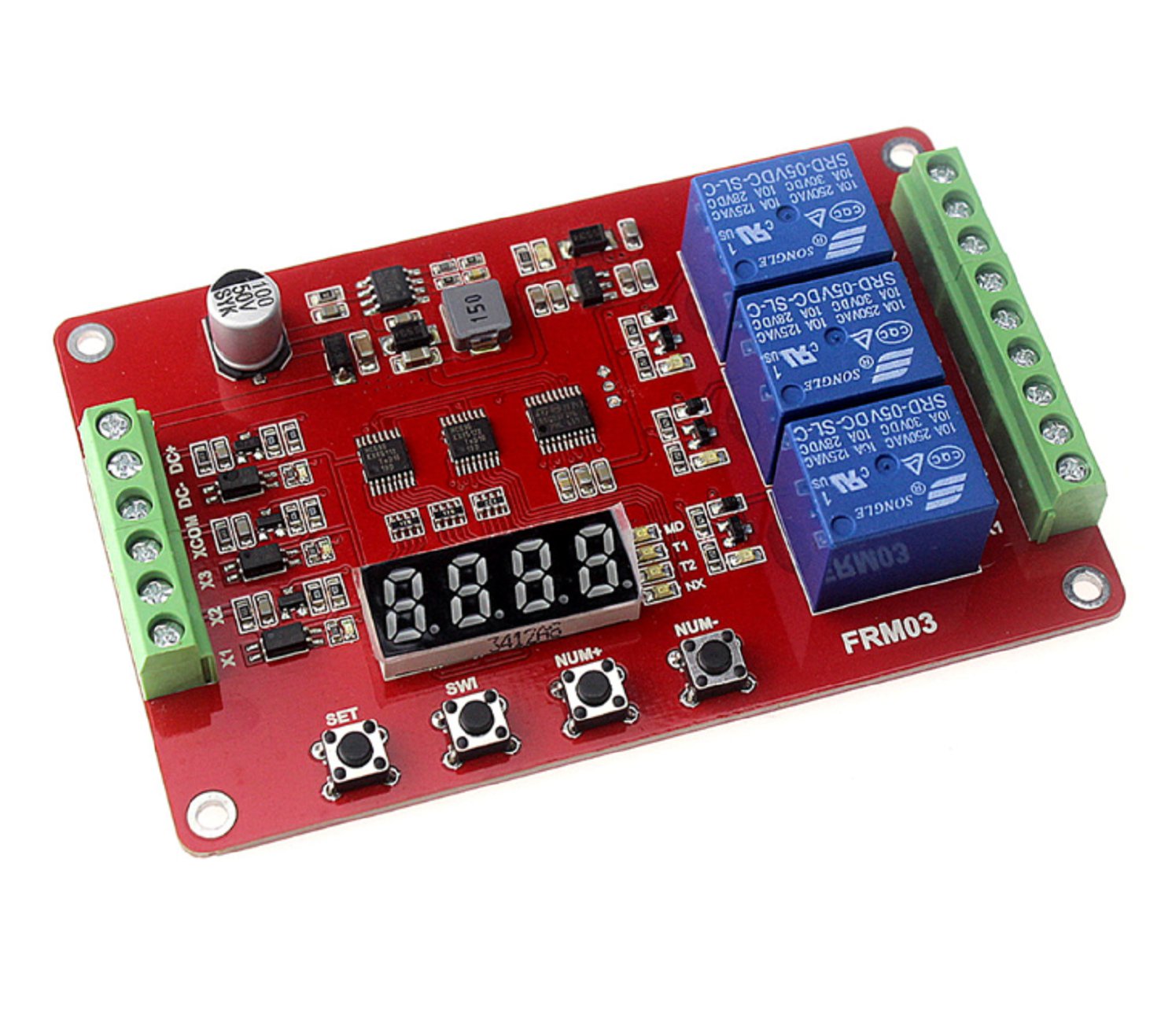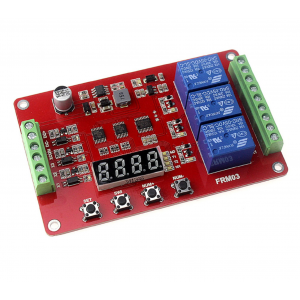HS1716 FRM03 relay module cycle delay timing switch self-locking module 18 function 8-32V
FRM03 multi-function relay module/cycle/delay/timing/switch/locking / 18 kinds of functions
aeProduct.getSubject()
FRM03 type 3 channels multifunction relay control module, designed for a variety of different needs of users, using microcontroller as the main control unit, as many as 18 kinds of preset functions, and can according to user requirements, customize and add other specific functions.
Module selects the authentic high quality components, military level PCB board, cloth plate considering comprehensive, stable performance and can be widely used in all kinds of power control class.
Function characteristics:
1. With 3 channel input and output control, each channel can be set up respectively 18 kinds of function, meet the demand of more applications;
2. 8 v dc - 32 v wide voltage input, has the function of power meter, won't because of wrong damage of power supply module;
3. Has the red power indicator light, light green terminal input, relay and light blue;
4. Can be set to at least 0.1 seconds time function, timing accuracy is better than the 0.01 seconds;
5. Increase the automatic power saving function, users can set by oneself;
6. All Settings, can automatically save, set the content no lose when power supply drop;
7. The trigger signal input allows users to choose high level or low level trigger pulse;
A module function
Users can through the buttons and display, set and select the following one of 18 kinds of functions, can be set and save function parameters, adjustable parameter is set minimum 0.1 seconds, precision is better than that of 0.01 seconds, on specific set of instructions, you can ask the seller to claim.
Warm prompt:
On 1-8 1. The function will automatically start when the electricity, the function of 9 to 18 need high (low) level pulse signal to trigger the start (high (low) level duration of not less than 20 ms, the same below), 9 is the function of the lock mode, the function is 10 level control mode.
2. The following text mentioned X interface, can be the X1 - either in the X3 interface.
Feature 1:
Electrical delay on and off: starting from the electricity delay after the T1 time, relay or absorption, T1 adjustable between 0.1 seconds - 270 hours, at any time to X interface a high (low) level pulse signal, this function reset and start running again;
Feature 2:
On electrical delay disconnect: electric relay or absorption, and after the T1 time, relay disconnect, adjustable between T1 in 0.1 seconds - 270 hours, at any time to X interface a high (low) level pulse signal, this function reset and start running again;
Feature 3:
On the timing and then disconnect: electric relay when disconnected, disconnect time T1 arrival relay; Off upon arrival time T2 relay disconnect, between T1 and T2 in 0.1 seconds - 270 hours, at any time to X interface a high (low) level pulse signal, this function reset and start running again;
Features 4:
Regularly disconnect again and: electric relay or absorption, and time after T1 to relay disconnected; Turn off time T2 relay and upon arrival, T1 and T2 adjustable between 0.1 seconds - 270 hours, at any time to X interface a high (low) level pulse signal, this function reset and start running again;
Function of 5:
In an infinite loop pattern 1: when the electric relay disconnect, disconnect time T1 arrival relay; And off time T2 relay disconnected upon arrival, and then repeat the above state; Between T1 and T2 in 0.1 seconds - 270 hours, at any time to X interface a high (low) level pulse signal, this function reset and start running again;
Features 6:
On an infinite loop pattern 2: electric relay immediately or absorption, and time after T1 to relay disconnected; Turn off time T2 relay and upon arrival, and then repeat the above condition, T1 and T2 adjustable between 0.1 seconds - 270 hours, at any time to a high (low)/X interface level pulse signal, this function reset and start running again;
Function 7:
On the limited circulation pattern 1: electric relay when disconnected, disconnect time T1 arrival relay; And T2 time relay disconnected upon arrival, then repeat above NX times, between T1 and T2 in 0.1 seconds to 9999 seconds is adjustable, cycles NX adjustable between 1-9999 times, at any time to X interface a high (low) level pulse signal, this function reset and start running again;
Function 8:
Limited cycle timing mode 2: the electric relay or absorption, and time after T1 to relay disconnected; Turn off time T2 relay and upon arrival, then repeat above NX times, between T1 and T2 in 0.1 seconds to 9999 seconds is adjustable, cycles NX adjustable between 1-9999 times, at any time to X interface a high (low) level pulse signal, this function reset and start running again;
Function of 9:
Latching relay mode: relay X interface to a high (low) level pulse signal, relay or absorption, give a high (low) level pulse signal relay disconnect.
Function of 10:
Level trigger relay mode (including delay off function) : when the electric relay on disconnect, X interface to a high (low) level signal, relay and off immediately, X port signal disappears, relay and still, when T1 and time relay disconnect after he arrived, the T1 adjustable between 0 seconds - 270 hours.
Note: this function, if the T1 is set to 0 seconds, becomes: X port has a high (low) level signal relay and off, no signal is disconnected immediately.
Function of 11:
Trigger timing and off: the electric relay when disconnected, X interface to a high (low) level pulse signal, delay the T1 time relay, adjustable between T1 in 0.1 seconds - 270 hours, repeated X to interface a high (low) level pulse signal, repeat the above function;
Features 12:
Trigger timing disconnect: electric relay when disconnected, X interface to a high (low) level pulse signal, relay, absorption and T1 time relay disconnect, adjustable between T1 in 0.1 seconds - 270 hours, repeated X to interface a high (low) level pulse signal, repeat the above function;
Function of 13:
On the trigger timing and then disconnect: electric relay when disconnected, X interface to a high (low) level pulse signal, disconnect time T1 arrival relay; Off upon arrival time T2 relay disconnect, between T1 and T2 in 0.1 seconds - 270 hours is adjustable, repeated X to interface a high (low) level pulse signal, repeat the above function;
Function of 14:
On the trigger timing disconnect again and: electric relay when disconnected, X interface to a high (low) level pulse signal, relay, absorption and time relay after T1 to disconnect; Turn off time T2 relay and upon arrival, between T1 and T2 in 0.1 seconds - 270 hours is adjustable, repeated to X interface a high (low) level pulse signal, repeat the above function;
Features 15:
In an infinite loop pattern 1: when the electric relay disconnect, X interface to a high (low) level pulse signal, delay time T1 arrival relay; And off time T2 relay disconnected upon arrival, and then repeat the above action, between T1 and T2 in 0.1 seconds - 270 hours is adjustable, repeated X to interface a high (low) level pulse signal, can start again above functions;
Function of 16:
On an infinite loop pattern 2: when the electric relay disconnect, X interface to a high (low) level pulse signal, relay, absorption and T1 arrival time relay disconnected; Turn off time T2 relay and upon arrival, and then repeat the above action, delay between T1 and T2 in 0.1 seconds - 270 hours is adjustable, repeated X to interface a high (low) level pulse signal, can start again above functions;
Features 17:
Limited cycle timing pattern 1: electric relay when disconnected, X interface to a high (low) level pulse signal, disconnect time T1 arrival relay; And off time T2 relay disconnected upon arrival, then repeat above NX times, between T1 and T2 in 0.1 seconds to 9999 seconds is adjustable, cycles NX adjustable between 1-9999 times, repeated to X interface a high (low) level pulse signal, can start again above functions;
Features 18:
Limited cycle timing mode 2: the electric relay when disconnected, X interface to a high (low) level pulse signal, relay and off immediately, and time after T1 to relay disconnected; Turn off time T2 relay and upon arrival, then repeat above NX times, at this time between T1 and T2 in 0.1 seconds to 9999 seconds is adjustable, cycles NX adjustable between 1-9999 times, repeated X to interface a high (low) level pulse signal, can start again above functions;
Two electrical parameters
Working voltage: recommended 8 v dc - 32 v (limit working voltage 6 v dc - 40 v)
Rated power: static power (relay not suck right) is less than 0.2 W
Maximum power (relay all suck right) is less than 1.8 W
Working temperature: recommended - 20 ° to 60 ° (limit working temperature range - 30 °, 70 °)
Load capacity: relay often start mouth maximum load capacity: dc 0 to 30 v / 10 a, 0-250 - v / 10 a communication
Relay normally closed port maximum load capacity: dc 0 to 28 v / 10 a, 0-125 - v / 10 a communication
Use restrictions: 1. The service life of the relay is packed with action 100000 times, therefore more suitable for use in, a lower on-off frequency heavy current control occasions, not suitable for use in rapid action again and again;
2. Pay attention to consider the relay port load margin, pure impedance load to have more than 1 times allowance, ordinary inductive or capacitive load at least three times more allowance.
Three module interface
Voltage/signal input module: there are 6 line interface, all interfaces are terminal blocks, convenience for the user
1, the DC + : DC power to the anode
2, DC - : negative DC power supply
3, XCOM: photoelectric isolation signal at the input of public
4, the X1: input signal detection interface 1
5, X2: input signal detection interface 2
6, the X3: input signal detection interface. 3
Note: input signal detection interface, can be effective, high level can be low level effectively, the user can through the selection of XCOM mouth, if XCOM connect power anode, X1 - X3 is high effective, positive if XCOM, X1 - X3 is low level and effective!
Relay load output: there are 9 line interface, all interfaces have terminal blocks
1, no. : the first relay all the way open interfaces, often before the relay and impending, after absorption and COM1 short answer
2, COM1: the first relay all the way the public interface
3, NC1: the first relay all the way normally closed interface, relay and with short COM1, before and after the impending
4, NO2: normally open interface of the first two relays, relay and impending, before and after absorption and COM2 short answer
5, COM2: public interface of the first two relays
6, NC2: the first two relays normally closed interface, relay with short before and COM2, dangling after absorption
7, NO3: the third road relay normally open interface, relay and impending, before and after absorption and COM3 short answer
8, COM3: the third road relay public interface
9, NC3: the third road relay normally closed interface, relay and with short COM3, before and after the impending





